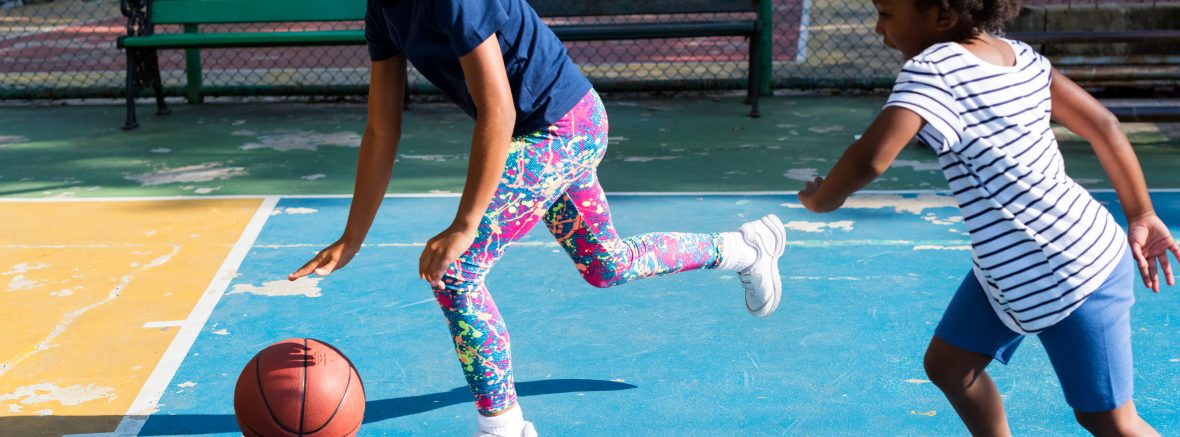These drills are from defensive expert Jim Huber. If you don’t know Jim, he’s trained some of the best youth and high school players in the world. At the high school level, he’s trained NBA players such as Michael Porter Jr, Willie Cauley-Stein, Alec Burks, and Semi Ojeleye.
His team also led the Nike EYBL in defensive points per game which features the best high school players in the country! Additionally, he won the Nike Global Challenge with Team USA West.
So Jim knows a thing or two about defense… Let’s get to the drills!
Defense Drill #1: 4 On 3 Overload Drill
In the game of basketball, there are many situations where you have to scramble and match up with players; like rotating out of help defense and in transition. This is one of the best drills to improve your ability to scramble and match up.
Your defense is at a constant disadvantage and it forces them to hustle, communicate, and rotate.
In this 4 on 3 situation, someone will always be open, but with good positioning and effort you can keep things under control. This drill can also be done as a 5 on 4 type of drill.
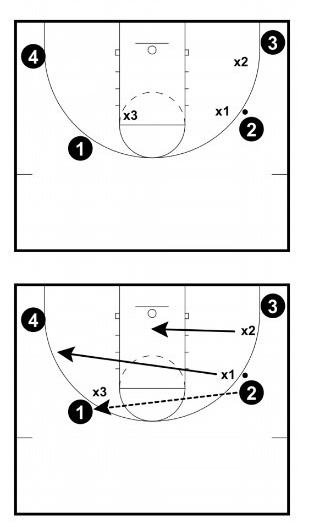
Points of Emphasis:
- Effective Close Outs – If you are not going all out on our close outs in this drill, you will be exposed pretty quickly. You are already down in numbers, if someone isn’t closing all out and under control, you are beaten before you even start.
- Sprint To Areas / Effort – Hold people accountable on effort. Make sure they are sprinting to areas.
Coaching Tips
- Progress To More Situations and Increase Difficulty – After you are satisfied with the concepts sinking in, you can allow the offense free movement, interchanges, screens etc.
Defense Drill #2: No Paint Drill
This is one of the best drills at eliminating penetration into the paint! It really develops a mentality of protecting the paint and not letting anybody get in there.
If you believe that penetrating via the pass or the dribble is one of the best offensive weapons, this drill is a must!
It’s also a great all around defensive drill for practicing proper defensive habits.
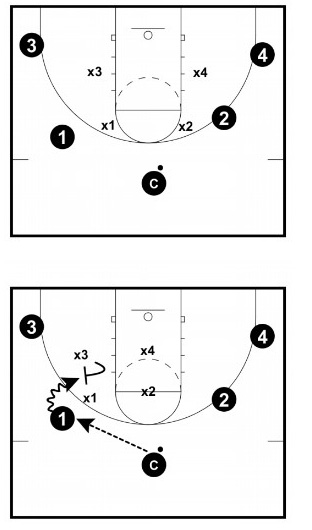
Variations:
3-Point Shot Hits Rim – A progression would be to add that the offense can score another point by taking a three point shot that hits the rim. This forces defenders to maintain intense ball pressure.
Excessive Fouling – You want our players playing hard on defense, but playing smart. Fouling and putting people on the free throw line is unacceptable. It’s not playing smart. The next progression in the drill is to begin awarding points if you are seeing excessive fouling and hand checking to stop the penetration. Make them stop the ball with their feet moving, not their hands reaching.
Defense Drill #3: 5 on 5 Whistle Change
This drill works on your defenders’ ability to scramble and pick up a different player when a game situation forces them to do so. This often happens in transition and rotating out of help defense. Communication is a must in this drill and your players will be forced to improve.
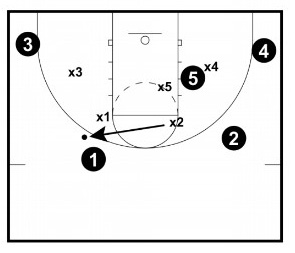
Points of Emphasis:
- Communicate! – Players must communicate in this drill. If they don’t, they will fail. Forcing players to talk and think on their feet as they scramble is making practice harder than what they will likely face in a game situation. Anytime you can do that in a drill, your team stands to benefit in the game.
- Stop the Ball – Even though players are matching up in the drill, they must be aware of the ball handler. The ultimate goal is to stop the offense from scoring, so help defense must be alert and stop the ball when necessary.
Variations:
Full Court – You can also play the game full court as a variation. You don’t even have to start in a half court setting. Make sure to keep the team’s baskets the same, though.
Coaching Tips:
- Variety – Make sure to vary who has possession of the ball and the location of the ball when blowing the whistle.
- Keep Coaching Defense – Keep coaching proper defensive fundamentals throughout the drill. Make sure that they close out properly, maintaining good position, rotate on help, defend screens properly, etc.
Defense Drill #4: 1 on 1 Close Out
If you don’t have great defensive close outs, it doesn’t matter how great your help defense is when you are at a constant disadvantage, the offense is going to score a lot.
And think about this, you can have anywhere between 100 to 250 close outs per game. Multiply that over the course of a season, you might have 2,000 to 10,000 close outs per season!!
Poor close outs can destroy your defense which will lead to the offense scoring more points against you. In order to have a great defense night in and night out, you must be able to defend the basketball in a one on one setting.
This is a fast-paced drill to practice in order to get better at closing out, contest shots, and prevent dribble penetration. It forces defenders to learn how to defend in a game-like environment. There is nothing better than improving on ball defense by putting the defensive player out on an island and forcing the defender to stop the player one on one.
Setup:
- Defense, X1 and X2 start under the basket. Each player has a basketball.
- The two offensive players are positioned on the wings.
Instructions:
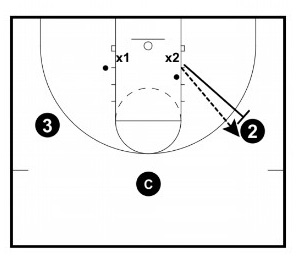
Points of Emphasis:
- Sprint To Eliminate Offensive Advantage – Defensive players should sprint on the close outs. The quicker you can contest a shot and immediately get into a balanced position to eliminate dribble penetration, the less of an advantage the offense will have.
- Hands Up – Depending on your preference, either have one hand or two hands up to contest the shot and immediate entry passes from the offensive player.
- Position Appropriately – Whether you believe in getting the defender’s butt to the basket or forcing the offensive player in a particular direction, be sure to position yourself appropriately. Bad positioning will create easy driving opportunities for the offense.
- Practice Good Offensive Habits – Make sure we emphasis the little things in every drill. Is the offense coming forward to catch the pass? Or are we being lazy, standing still waiting on the pass? Just because the focus of a drill is defensive, don’t let little things slide with the offensive players. If you let little things slide in practice, you’ll end up getting beat by little things in games.
Variations:
Loser Stays On Defense – If the offense scores, the defender must stay on defense until they get a stop. You can rotate the offensive player each repetition.
Add Passer – So the defender doesn’t know when the pass is going to occur, you can have the coach, manager, or other players pass. This will improve anticipatory skills and reaction speed for the defender as it emulates what will happen during a game.
Vary The Passing Position – You can also pass from different positions on the floor to close out from different angles and positions like you would during a game. You can also have coaches, managers, or other players act as passers.
Time Clock / Limited Dribbling – You can also have dribble limits and time clocks, so the offense also has to practice good offensive habits.
Coaching Tips:
- Alternate Sides – Go side to side for efficiency. When one pair is running live, another pair should be ready to go on the other side.
- Make Drills Competitive – Make the drills competitive by having players keep score. Create accountability.
Defense Drill #5: Man in the Hole
Even if you play half court or quarter court defense, this should be a staple for every coach. This is a great 1 on 1 transition drill that works on your ability to stay in front of a ball handler in the open court. You work on the shuffle, the quick turn, running, and the turn and sprint to recover.
Additionally, it’s great for conditioning and building mental toughness.
It not only improves your 1v1 full court defense, it improves overall athleticism and conditioning. When you have to shuffle, sprint, change directions over and over, you’re going to improve athleticism and reaction time.
Even zone defense coaches use drills like these because of the tremendous benefits that they produce.
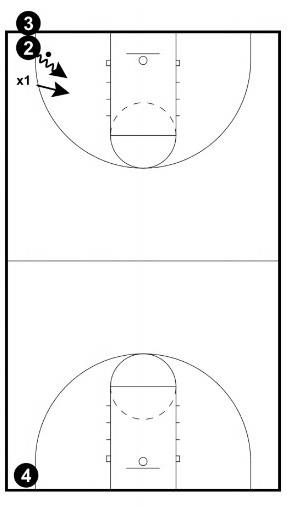
Points of Emphasis:
- Stop The Ball – The number one goal is to stop the ball from advancing.
- Push Step & Sprint – The defensive player should push step (shuffle) and sprint to contain the ball handler. If the defender gets beat, they need to turn and sprint to a spot to cut off the ball handler.
- Offense Practices Good Habits – The offense also needs to focus on good habits of protecting the ball and using effective change of pace and change of direction moves.
- Go Back To Where Defender Was Beat – If the offense gets by the defender, don’t let them just turn and jog to the other baseline. Have the defender and offensive player go back to where they got beat. This will ensure focus and effort to stop the ball.
Coaching Tips:
- Encourage Players – Encouragement and energy from the Coach can help keep a player going in a drill like this. Get involved and work with them!
- Split The Court – Be sure to split the court into alleys. You can set up three to four alleys on each court. This allows you to work the entire team with this drill. You can use cones or other lines on the court.
Defense Drill #6: 1 on 1 to 3 on 3 Full Court
Being able to defend the ball in a one on one situation is vital. However, you need to have the capability to transition into help defense in a team setting!
This drill is about building great 1on1 full court defense habits and transitioning into a half court setting. Then you work on all other aspects of your defense. Defending cuts, screens, getting into help position, stopping dribble penetration, etc. 3v3 defensive drills are also great because it’s tougher to defend the entire court with three players than with five players like during a game.
Additionally, the offense learns how to handle the ball under pressure and improve passing.
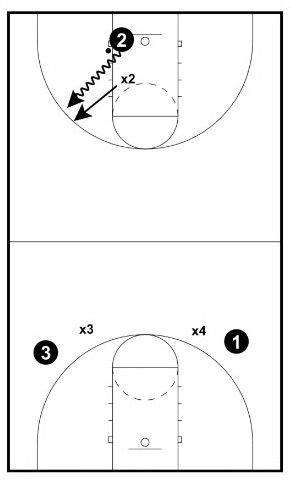
Points of Emphasis:
- Contain Ball – Your goal as a defender now is contain the ball. You do not allow straight line drives. You want to stay between your player and the basket!
- Wing Defenders Deny Pass – Defenders X3 and X4 are going to deny the pass on the wing and make it difficult to catch.
- Help And Recover – The defenders have to be ready to help and recover should the ball handler get past the initial defender.
- Help Across Not Up – If the ball handler beats the initial defender, the other defender, X3, is going to have to find a way to help slow the ball to give the recovering teammate time to get back. They should help “across” from their own player and keep the ball and their player in their line of sight. Try to stop the ball on the same level as your own player if possible. Helping “up” the court from your player in this situation will lead to the easy bucket on the lob ahead.
- Force Contested Jump Shots / No Lay Ups – Your Goal? Do not let the other team score! You do that by keeping the ball as far away from the basket as possible. Lay ups are NOT allowed! You want a contested jump shot as far from the basket as possible, with as much pressure and difficulty as possible.
Variations:
Force Turns Prior To Half Court – If you want to make the drill really challenging for the full court defender, you can reward them for the number of times that they force the ball handler to stop and change directions. Each change of direction is worth one point. Once they reach half court, it goes back to playing defense straight up.
Also, this can be a similar strategy to use against teams that lack effective ball handlers or if you have some superb 1 on 1 full court defenders.
Defense Stops – One effective tactic to get players to focus on the defensive end is to only allow them to transition to offense by getting a defensive stop. If they don’t get a stop, a new group of defenders comes in to stop the ball. If you score on offense, you stay on the court.
Winner Stays – You can set up teams of three and play to a determined amount of points. The winners stay on the court.
Defense Drill #7: 4 On 4 Shell Drill
The shell drill is a great tool for teaching your defense. From a big picture perspective, you can quickly teach your players exactly what your team defense should look like.
You can practice all of your defensive concepts in a team situation. You work on ball defense, being in a great stance, closing out, jumping to the ball, sprinting areas, and other key defensive concepts.
You can practice defending any situation. You can practice defending all types of cuts, screens, and offensive actions. You can practice defending basket cuts, backdoor cuts, flare cuts, down screens, ball screens, back screen, staggered screens, horns sets, Princeton sets, etc.
It’s also great because it allows you to be efficient with your team. You can have four or five defenders practicing defense all at once.
You can also use the shell drill to work on specific defensive techniques. That way, if you’re struggling with a particular offensive action, you can break it down and make sure your players understand how to defend in that situation. Also, you can get a bunch of reps in a short amount of time to solidify their learning.
The following is a beginner progression for teaching the shell drill. You can also see progressions for teaching how to defend down screens and back screens.
Set Up:
You position four or five offense players on the court.
You position a defender guarding each offensive player.
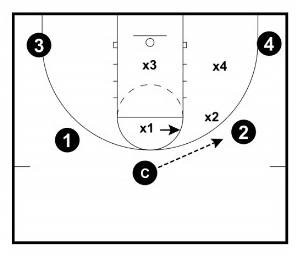
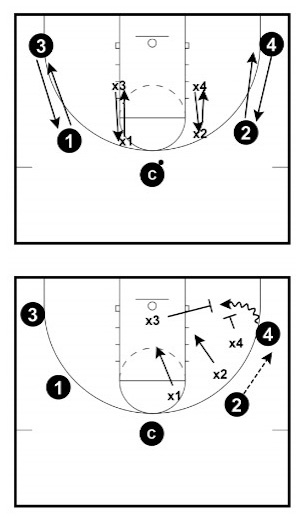
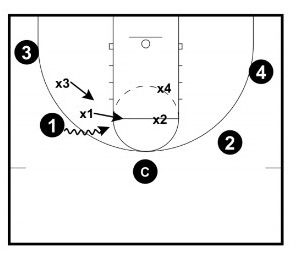
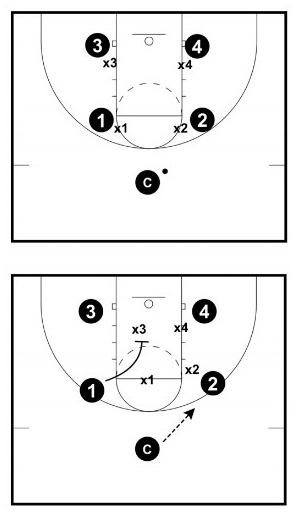
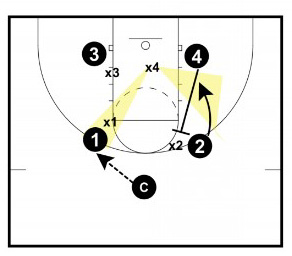
Points of Emphasis
- Jump To The Ball – Make sure we are anticipating the pass and jumping with ball, not reacting to the pass being caught. Move with the ball like you have a magnet in your chest.
- No Layups – Seal the seams and force the ball outside the scoring area, the area that we consider our “house”.
- Don’t Hug Your Player – Don’t hug your player when they are going to set a screen. If you hug the player, play too closely, the screener might be able to set a “double” screen and screen you and a teammate at the same time. Stay up the line, on the line from the ball and give the player being screened enough room to get through.
- Ball Side Of Down Screen – Jim teaches the defenders to go “ball side” of the screen, so we are coming up the middle in a help position. In the bottom diagram, X3 would fight to get around the screen on the ball side where the offense, 1 in black, has received the ball.
- No Lobs – Non Negotiable on Defense – We do not allow LOBS on back screens.
- Get Skinny On Screens – When your player calls out the screen, get “skinny”. Turn at an angle that makes you more difficult to screen and be ready to move. If you get caught “fat and flat” by that back screen, you are going to have a difficult time recovering and getting round the screen.
Coaching Tips
- Demand Great Effort – Be sure they sprint to areas and give maximum effort. Often players think they are giving maximum effort, but they are not. Immediately correct and rep out until the player does this correctly. Playing with great effort can help you overcome a lot of mistakes.
- Master The Basics / Don’t Rush – When it comes to youth and high school basketball, don’t worry about progressing until you master the basics of positioning, help defense, communication, and effort. If you do these things, it can counter many things that the offense throws at you.

